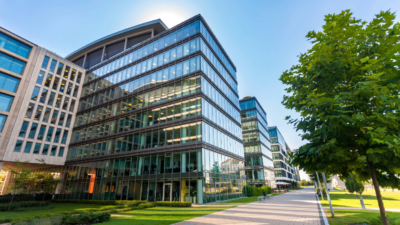In our series so far, my global workplace strategy colleagues and I have covered four of the five key shifts that companies must make in the workplace over the next five years:
- Make employee experience a core part of business strategy
- Build the “Internet of Workplace”
- Create a workplace that makes people healthier
- Ingrain the co-working mentality in real estate strategy
And now we arrive at the final trend shaping workplace strategy around the globe: the importance of the agile organization and a workplace designed to support it.
Most organizations are structured so that dedicated teams with certain expertise work on specific products or services for clients. These teams consist of people with similar knowledge levels and skills and are more or less fixed in terms of long-term composition.
Yet due to changing client demands, quickly shifting environments and evolving technologies, more and more organizations are starting to rethink this structure. They are applying more focus on collaboration between teams and breaking down silos, while bringing diverse expertise and backgrounds together to better serve clients. The result is a heightened focus on the larger business ecosystem instead of a focus on developing single, stand-alone products.
This is where agility comes in. The “agile organization” is a term that’s getting a lot of attention right now, serving to reflect a focus on flexibility, viability and collaboration — which has a direct impact on work environment requirements and workplace design. But what is an agile workplace and how can it support the type of nimbleness that drives true business results?
Roadmap to 2022: Understand the Origins of the Agile Organization
The roots of agile working lie in information technology companies. Many of these companies employ a time-constrained, iterative approach to software delivery that builds a product incrementally instead of trying to deliver a single product all at once. The agile approach embraces change, which contradicts the traditional project approach in which teams define detailed specifications and create formal processes that largely seek to avoid change.
Spotify is a great example of a company that points to an agile engineering culture as one of its main success and growth factors. Spotify started in 2006 as a single agile team consisting of people with different backgrounds.
Soon, Spotify started growing into a number of teams, aligned by a key driving force of autonomy and a strategy of working in small (no more than eight people), cross-functional, self-organizing teams called “squads.” Spotify now has more than 70 squads with end-to-end responsibility for what they decide to build, how they build it and how they work together.
Today, a growing number of organizations across a wide range of industries have adopted agile work practices — and they are seeing meaningful results. The 10th Annual State of Agile™ Report shows that over the past five years, the top three benefits of implementing an agile approach are an ability to manage changing priorities, increased team productivity and improved product visibility. According to a study from McKinsey & Company, businesses that are deploying agile development at scale have accelerated their innovation by up to 80%.
While companies like Spotify started with an agile structure, many companies — like ING, Amazon, Microsoft and Vodafone — are showing that the transition from a more traditional structure to an agile one is possible.
In 2015, ING was the first bank to shift to an agile organizational structure. Three main reasons drove the decision: to become efficient and flexible, to innovate faster and achieve a shorter time to market, and to become a more attractive employer.
ING employees work in self-steering, autonomous squads that each bring together people from multiple disciplines to complete a project successfully. Squads that are involved in the same area of work are part of a larger organizational entity: the tribe.
This new agile approach provides ING with the flexibility to adapt to the needs of the moment and achieve faster turn-around times. This is a completely new way of working that has demanded a cultural shift and a new agile work environment.
Source: The ING Way of Working.
Roadmap to 2022: Incorporate Agility in the Work Environment
So how are companies successfully making the shift to agile structures? They are recognizing that one of the enablers of an agile organization is a work environment aligned with the agile working principles. Because the way people work in agile teams differs from the way people work in a traditional model, this requires a change in the characteristics of the work environment.
There’s no doubt that you’ve heard about the rise of “activity-based work environments,” in which individual employees share workspaces and choose a space based on the activities they perform. An agile organization requires something slightly different — and that difference has to do with making the team’s needs the central focus of workspace organization rather than the needs of the individual.
While there isn’t a single way to create the agile work environment, there are four key differences between an agile and activity-based work environment to keep in mind:
- Agile working requires less workspace variety – In agile organizations, bringing together people with different areas of expertise and backgrounds is key for productivity. In terms of workplace design, the focus is not on facilitating individual workstyles and activities, but on facilitating multi-disciplinary teams. This means an employee is likely to spend most of their time next to direct team members and less time switching between different workspaces in the office. This differs from activity-based work environments, in which people more often move between diverse spaces based on individual preferences.
- Agile working limits flexible workplace usage – It sounds contradictory, but agile working can limit the flexible use of the work environment. To collaborate closely, an agile team spends most of its time during a specific project in one block of workspaces dedicated to that project. In most cases, unoccupied workstations in these dedicated blocks are not used by other teams. One challenge is that this can lead to lower space efficiency than in activity-based work environments, where it is more likely that employees use all available desks in the office or in their dedicated areas.
- Agile working increases workplace occupancy – To boost collaboration between people with different areas of expertise and backgrounds, agile organizations must be able to bring people physically together to work. The so-called “stand-ups” and other types of in-person collaboration are key, which means that more people will come to the office and average occupancy rates will increase.
- Agile working requires fewer meeting rooms but more breakout spaces for highly concentrated work – In agile working, formal planned meetings are replaced by short, effective “meeting moments” and continuous informal collaboration within teams. Meetings mainly take place on the floors instead of closed, separate rooms. Because most activities are performed in open, team-oriented spaces, this often leads to more dynamic, talkative spaces. This does carry a risk that people might face difficulties if they require quiet space in which to perform concentrated work.
Get Started Now
Think critically about the ways your business might change in the coming years. How might agile work practices support your business through increased flexibility, innovation and collaboration? How can you create a workplace that adapts to these organizational changes?
One key is designing your work environment to support intensive collaboration and the needs of the team, which can require a slightly different approach than activity-based working. Here are a few key considerations:
- Provide the right spaces and tools to enable teams of 8–10 to work closely together. Dedicate areas for those teams that facilitate collaboration, such as stand-up areas with whiteboards or “smart boards.” Make it easy to conduct spontaneous meetings, gather around screens or even access whiteboard content remotely.
- Consider the way teams are located and how common areas and pathways through the office can optimize ad hoc connectivity.
- Remember that while agile work is all about intensive collaboration, individual work will always be important. To stay flexible and prevent “room-claiming behavior,” creating quiet areas and library-type areas within open spaces can be more beneficial than a cluster of small concentration rooms.
- Ensure that spaces can be used flexibly and multi-functionally without the need for major refurbishments when activities and team composition change. If designed correctly, an open space can be used for team collaboration and then if needs change, the same area could be used in a different way without significant refurbishment. The key is incorporating techniques like dynamic lighting, digital signage, collaboration screens and reconfigurable furniture to change an area’s look and feel and make it intuitive to use for diverse activities.
By adopting the agile mindset and creating a workplace to support these practices, you will be better placed to not only adapt to the changing needs of your clients and the marketplace, but to stay a step ahead.
This post is part of a series on the five workplace trends that Colliers’ global workplace experts see as the most crucial for companies to align with in the next five years. Stay tuned for one final post highlighting key next steps for companies to take, as well as a full white paper on this topic. In the meantime, contact the workplace expert in your region for more insights and information.
Contact
Americas
Keith Perske
Head of Workplace Solutions
Keith.Perske@colliers.com
+1 512 673 3653
Australia & New Zealand
Peter Black
Head of Workplace Solutions
Peter.Black@colliers.com
+61 2 9249 2065
EMEA
JanJaap Boogaard
Head of Workplace Solutions
JanJaap.Boogaard@colliers.com
+31 10 412 00 35
North Asia
Truddy Cheung
Head of Workplace Solutions
Truddy.Cheung@colliers.com
+852 2822 0584
Southeast Asia
Samarth Kasturia
Head of Workplace Solutions
Samarth.Kasturia@colliers.com
+65 6531 8685

 Colliers Insights Team
Colliers Insights Team
 Franklin Wallach
Franklin Wallach Verity Mosquera
Verity Mosquera
 Marc Shandler
Marc Shandler Josh Cramer
Josh Cramer
 Jesse Tollison
Jesse Tollison